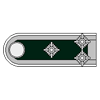Does anyone know of a method for removing the bronze/copper/nickle wrapping on guiter strings removing intact to be used as coil wrapped hydro lines oxygen hoses etc have tried heating and trying to pull of with plyers etc but not working any other methods or ideas greatly appreciated
Modeling in General
General discussions about modeling topics.
General discussions about modeling topics.
Hosted by Jim Starkweather
Remov guitar string wrap
mogdude

Member Since: June 18, 2012
entire network: 459 Posts
KitMaker Network: 264 Posts

Posted: Tuesday, April 09, 2019 - 12:37 PM UTC
Klaus-Adler

Member Since: June 08, 2015
entire network: 1,505 Posts
KitMaker Network: 70 Posts

Posted: Tuesday, April 09, 2019 - 12:48 PM UTC
can't you just cut the guitar string to size and bend it to the shape you want?
I did that using a sturdy pair of scissors and pliers to bend it into the desired shape.
I did that using a sturdy pair of scissors and pliers to bend it into the desired shape.
mogdude

Member Since: June 18, 2012
entire network: 459 Posts
KitMaker Network: 264 Posts

Posted: Tuesday, April 09, 2019 - 01:02 PM UTC
Its very stiff due to the wire inside and it needs to be very flexable for at least one operation I want to do the method you suggest will work for a lot of applications except this one
Kevlar06

Member Since: March 15, 2009
entire network: 3,670 Posts
KitMaker Network: 527 Posts

Posted: Tuesday, April 09, 2019 - 04:21 PM UTC
Have you tried to anneal it?
VR, Russ
VR, Russ

RobinNilsson

Member Since: November 29, 2006
entire network: 6,693 Posts
KitMaker Network: 1,042 Posts

Posted: Tuesday, April 09, 2019 - 05:50 PM UTC
If you are trying to replicate something looking like this:

I would go about that the other way around.
Wrap copper wire of a suitable gauge around a steel rod (drill bit if it is long enough) and then slide the coil off the steel rod.
Instead of trying to slide the coils off a guitar string I would start by making a "model" of the guitar string and then start getting the coil off from the copy.
The coils on the guitar string look perfect when they are on the guitar string but if getting them off ruins them it might be easier to make a look-a-like first.
The difficult bit is to wind the copper wire just tight enough without making it difficult to slide off afterwards.
Annealing the wire could make it easier ...
/ Robin

I would go about that the other way around.
Wrap copper wire of a suitable gauge around a steel rod (drill bit if it is long enough) and then slide the coil off the steel rod.
Instead of trying to slide the coils off a guitar string I would start by making a "model" of the guitar string and then start getting the coil off from the copy.
The coils on the guitar string look perfect when they are on the guitar string but if getting them off ruins them it might be easier to make a look-a-like first.
The difficult bit is to wind the copper wire just tight enough without making it difficult to slide off afterwards.
Annealing the wire could make it easier ...
/ Robin
Posted: Tuesday, April 09, 2019 - 09:26 PM UTC
The method Robin suggests works very well.
mogdude

Member Since: June 18, 2012
entire network: 459 Posts
KitMaker Network: 264 Posts

Posted: Tuesday, April 09, 2019 - 10:31 PM UTC
thanks to all will try the wrapping idea

RobinNilsson

Member Since: November 29, 2006
entire network: 6,693 Posts
KitMaker Network: 1,042 Posts

Posted: Wednesday, April 10, 2019 - 01:34 AM UTC
It may not work perfectly on the first attempt but the copper wire can be straightened and used for a new attempt so don't give up too quickly 

Kevlar06

Member Since: March 15, 2009
entire network: 3,670 Posts
KitMaker Network: 527 Posts

Posted: Wednesday, April 10, 2019 - 03:51 AM UTC
I understand where he's coming from with the guitar string, as opposed to the "wrapping" method. With wrapping, it's still hard to replicate the tight wind and thickness of many types of antenna bases or oxygen hoses (but the wrapping method still works well for many different applications). When I want really tight and thick patterns of hoses and springs (such as in rubberized fabric oxygen hoses and tight antennae base springs), I like to use guitar metal string. These strings are designed to be stiff, but If you start with small lengths, and heat at the end where the inner wire protrudes slightly, using a small Bernzomatic torch, you can heat the wire enough that it will loosen and you can slide the outer "spring" wire off. However, if you overheat it, the wrapping wire will soften and bend just like normal wire will, which defeats the purpose. I heat the whole thing until it glows orange momentarily, and then I can bend it easily with the inner wire still inside for support. I usually cut the guitar wire into lengths just a little longer than I need with a Dremel cut-off disk before I anneal it, then I use a pair of nippers to expose a length of the inner wire to use as a "mounting rod" in a corresponding hole drilled in the model.
Now, if you are trying to make suspension springs, which are buried where they are not readily visible, there is another method I like to use-- I find a miniature brass screw with generally the same diameter and thread twist of the part I'm replicating (check your local hardware store, good ones have a selection of screws that are suitable). Cut off the head off the screw, chuck it in your Dremel tool, and "turn" it at low speed against a metal file to cut the "sharpness" of the threads to the desired point. This method can also be used to create "flat" springs by taking the thread down to the bottom of the groove.
VR, Russ
Now, if you are trying to make suspension springs, which are buried where they are not readily visible, there is another method I like to use-- I find a miniature brass screw with generally the same diameter and thread twist of the part I'm replicating (check your local hardware store, good ones have a selection of screws that are suitable). Cut off the head off the screw, chuck it in your Dremel tool, and "turn" it at low speed against a metal file to cut the "sharpness" of the threads to the desired point. This method can also be used to create "flat" springs by taking the thread down to the bottom of the groove.
VR, Russ

Kornbeef

Member Since: November 06, 2005
entire network: 1,667 Posts
KitMaker Network: 13 Posts

Posted: Wednesday, April 10, 2019 - 05:00 AM UTC
A lot of guitar strings I've found to have a cord or fibre core as opposed to steel. Heating them up to cherry red burns a lot of it away,
Posted: Wednesday, April 10, 2019 - 12:06 PM UTC
I have a method for making coil suspension springs using Plastruct's plastic coated wire. However I don't know if they make this product in small enough diameters to satisfy your needs. (3/64" dia. is the smallest they make.) However this technique should work for even the smallest diameter uncoated wire.
I started out using the traditional method of wrapping a single wire around the proper sized drill bit held in a vice. The problem there was after rolling the spring I tried to expand it but the coils came out with an irregular spacing between the loops.
I then struck on the idea of rolling two wires at the same time. This keeps the spacing between the loops uniform and allows you to make two matching springs at a time with each effort.

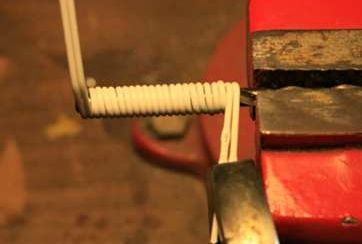

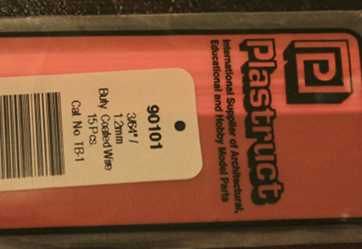
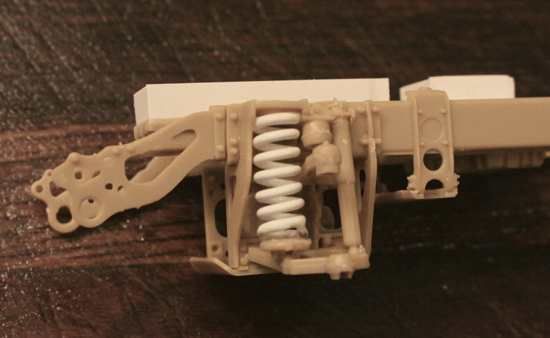
An immediate visual improvement in the suspension for the many
Oshkosh built US Military vehicles and heavy truck models being offered.
I started out using the traditional method of wrapping a single wire around the proper sized drill bit held in a vice. The problem there was after rolling the spring I tried to expand it but the coils came out with an irregular spacing between the loops.
I then struck on the idea of rolling two wires at the same time. This keeps the spacing between the loops uniform and allows you to make two matching springs at a time with each effort.





An immediate visual improvement in the suspension for the many
Oshkosh built US Military vehicles and heavy truck models being offered.
mogdude

Member Since: June 18, 2012
entire network: 459 Posts
KitMaker Network: 264 Posts

Posted: Wednesday, April 10, 2019 - 12:35 PM UTC
More great ideas thanks much , what I am trying to replicate are the steering hoses which you see with coil springs wrapped around them

RobinNilsson

Member Since: November 29, 2006
entire network: 6,693 Posts
KitMaker Network: 1,042 Posts

Posted: Wednesday, April 10, 2019 - 05:23 PM UTC
Could you post an image of one of those steering hoses?
Model in which scale?
Diameter of the real hose?
/ Robin
Model in which scale?
Diameter of the real hose?
/ Robin
mogdude

Member Since: June 18, 2012
entire network: 459 Posts
KitMaker Network: 264 Posts

Posted: Wednesday, April 10, 2019 - 10:59 PM UTC
1/35 Tacome G6 Rhino
Diameter unk
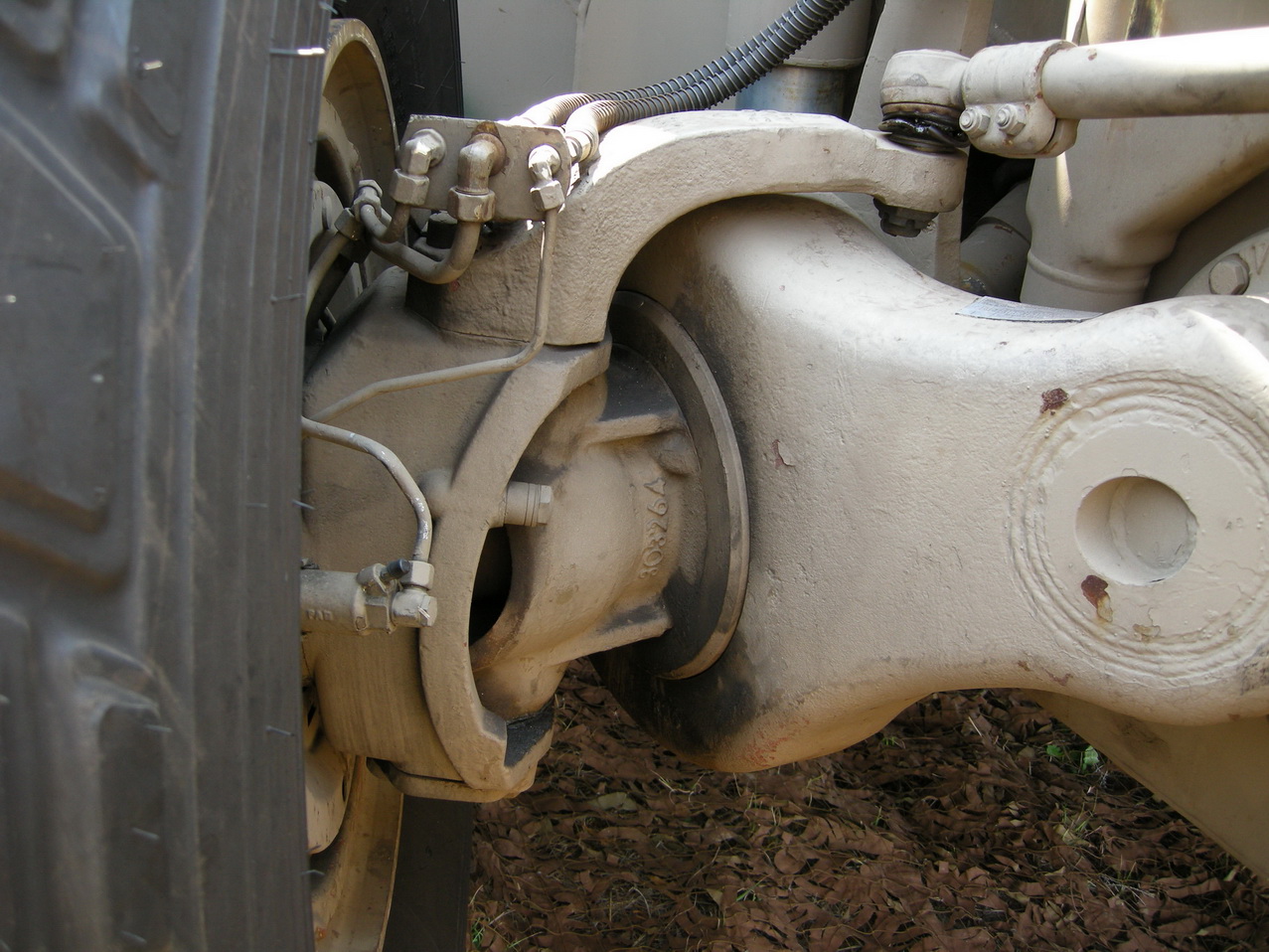
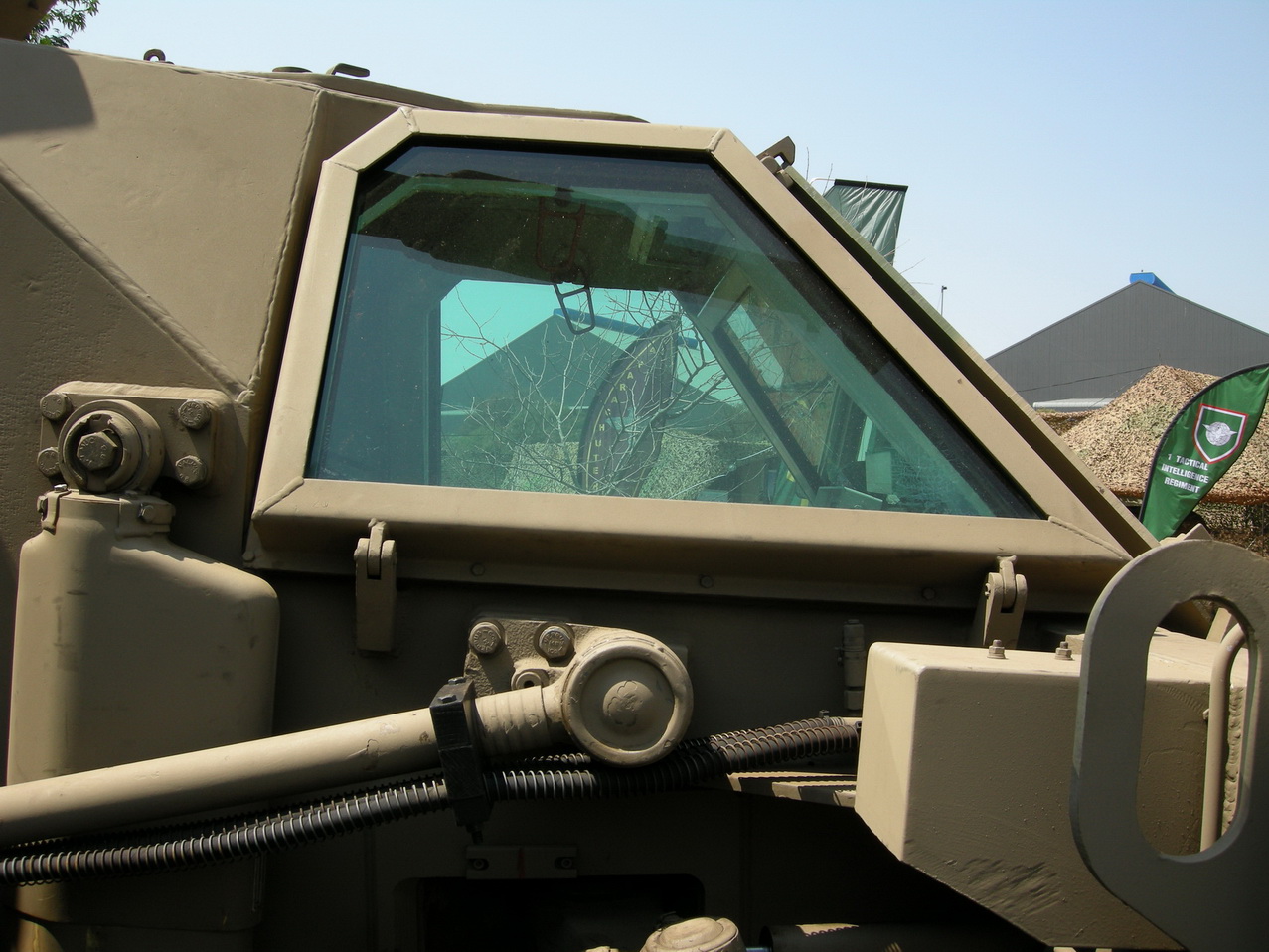

Diameter unk




RobinNilsson

Member Since: November 29, 2006
entire network: 6,693 Posts
KitMaker Network: 1,042 Posts

Posted: Thursday, April 11, 2019 - 12:55 AM UTC
OK.
I would use the method described by Michael Koenig but use three or four copper wires instead of two.
First anneal a brass wire or use similar gauge copper wire.
Take three or four thinner copper wires and wind them tightly around the thicker wire until the "hose" is long enough.
Carefully peel off two or three of the three or four wires so that only one remains. Peel off a few turns and follow with paint or small amounts of CA to lock the remaining wire in position. One small point per turn should be enough.
Carefully bend the "hose" to the desired shape and paint the whole thing. Very dark grey all over and then highlight the coils with "silver" or some other "shiny metal".
It could be possible to use thin solder as well, it might be trickier to do the winding but shaping it afterwards will be easier. Assuming you can get hold of a suitable dimension/gauge ...
You will have to use the Mk I eyeball to get the right gauge for the wires but I would guess somewhere around 0.5 to 0.8 mm for the inner pipe and 0.1 to 0.2 for the coils.
Make a few short trials with different size wires to get the best "look"
/ Robin
Edit:
See below for a great suggestion by Mike Freeman on materials.
I had heard about and completely forgotten about those
I would use the method described by Michael Koenig but use three or four copper wires instead of two.
First anneal a brass wire or use similar gauge copper wire.
Take three or four thinner copper wires and wind them tightly around the thicker wire until the "hose" is long enough.
Carefully peel off two or three of the three or four wires so that only one remains. Peel off a few turns and follow with paint or small amounts of CA to lock the remaining wire in position. One small point per turn should be enough.
Carefully bend the "hose" to the desired shape and paint the whole thing. Very dark grey all over and then highlight the coils with "silver" or some other "shiny metal".
It could be possible to use thin solder as well, it might be trickier to do the winding but shaping it afterwards will be easier. Assuming you can get hold of a suitable dimension/gauge ...
You will have to use the Mk I eyeball to get the right gauge for the wires but I would guess somewhere around 0.5 to 0.8 mm for the inner pipe and 0.1 to 0.2 for the coils.
Make a few short trials with different size wires to get the best "look"
/ Robin
Edit:
See below for a great suggestion by Mike Freeman on materials.
I had heard about and completely forgotten about those


justsendit

Member Since: February 24, 2014
entire network: 3,033 Posts
KitMaker Network: 361 Posts

Posted: Thursday, April 11, 2019 - 01:04 AM UTC
Hi John,
For what it’s worth... ‘UTC Ultra Wire’ is my go-to solution for easy to bend/coil hoses, brake lines, radio wires, springs, etc. The wire easily holds a desired shape, and in addition, its coating takes on acrylic primer very well. ... No stripping wires, heating, or fighting with pliers! I was able to find it here on Amazon. HTH.
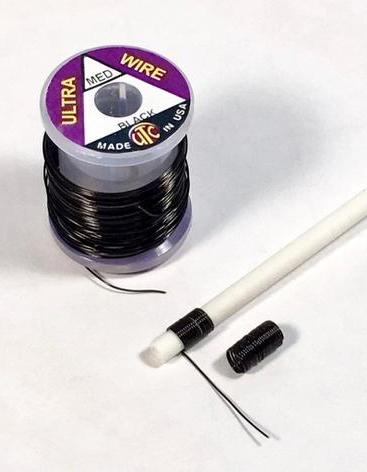
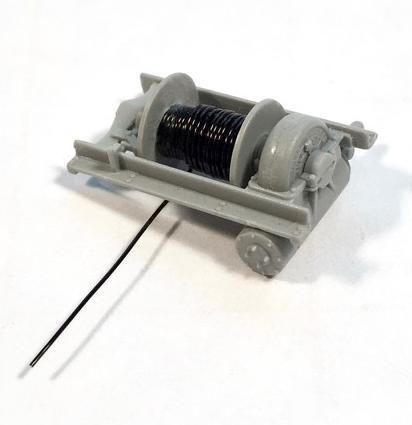
Test coils (Medium Black) easily wound around Evergreen tubing (left), and an M21 tow cable spool example (right).
Available sizes:
Large (26 gauge) (0.0180")
Medium (28 gauge) (0.0126")
Brassie (32 gauge) (0.0080")
Small (34 gauge) (0.0063")
Extra-Small (38 gauge) (0.0040")
Cheers!🍺
—mike
For what it’s worth... ‘UTC Ultra Wire’ is my go-to solution for easy to bend/coil hoses, brake lines, radio wires, springs, etc. The wire easily holds a desired shape, and in addition, its coating takes on acrylic primer very well. ... No stripping wires, heating, or fighting with pliers! I was able to find it here on Amazon. HTH.


Test coils (Medium Black) easily wound around Evergreen tubing (left), and an M21 tow cable spool example (right).
Available sizes:
Large (26 gauge) (0.0180")
Medium (28 gauge) (0.0126")
Brassie (32 gauge) (0.0080")
Small (34 gauge) (0.0063")
Extra-Small (38 gauge) (0.0040")
Cheers!🍺
—mike
Posted: Thursday, April 11, 2019 - 03:23 AM UTC
Quoted Text
Does anyone know of a method for removing the bronze/copper/nickle wrapping on guiter strings removing intact to be used as coil wrapped hydro lines oxygen hoses etc have tried heating and trying to pull of with plyers etc but not working any other methods or ideas greatly appreciated
John,
A lot of good suggestions here for various ways to make coils/wraps/etc., but to go back to your original question: Yes. I like to use guitar string for antennas, and I have found the wraps to be a reasonable approximation of the springy antenna bases. Here is how I do it: I cut a section of the string a bit longer than I want the antenna to be (I use junk diagonal cutters for this because guitar string will really do a number on your good cutters), and grip one end with vise-grips or something like that. You want to grab the other end with small pliers with grooved faces. Here you're trying to catch just the very end of the wrap with out actually squeezing it too hard. When you start to pull (it will take a good amount of force) the wrap should start to unwind from the core. Once you have unwound the wrapping to the point there is only an inch or so remaining, you should be able to unlock your vice grips and slide the wrap off the core. Last step is to cut the remaining wrap that hasn't been unwound to the length you want it and slide it back onto the core to complete your antenna.
This doesn't produce perfect antennas, but they are a lot less expensive than after market antenna bases. I saw in a recent post that carbon rod makes great antennas so I think i may try that, but I'll probably keep using guitar string wrap for the base.

Removed by original poster on 04/11/19 - 15:58:40 (GMT).
Removed by original poster on 04/11/19 - 15:59:41 (GMT).
mogdude

Member Since: June 18, 2012
entire network: 459 Posts
KitMaker Network: 264 Posts

Posted: Thursday, April 11, 2019 - 04:00 AM UTC
Quoted Text
Hi John,
For what it’s worth... ‘UTC Ultra Wire’ is my go-to solution for easy to bend/coil hoses, brake lines, radio wires, springs, etc. The wire easily holds a desired shape, and in addition, its coating takes on acrylic primer very well. ... No stripping wires, heating, or fighting with pliers! I was able to find it here on Amazon. HTH.
got to find some of this for lots of applications thank you
Test coils (Medium Black) easily wond around Evergreen tubing (left), and an M21 tow cable spool example (right).
Available sizes:
Large (26 gauge) (0.0180")
Medium (28 gauge) (0.0126")
Brassie (32 gauge) (0.0080")
Small (34 gauge) (0.0063")
Extra-Small (38 gauge) (0.0040")
Cheers!🍺
—mike
mogdude

Member Since: June 18, 2012
entire network: 459 Posts
KitMaker Network: 264 Posts

Posted: Thursday, April 11, 2019 - 04:00 AM UTC
Quoted Text
Quoted TextDoes anyone know of a method for removing the bronze/copper/nickle wrapping on guiter strings removing intact to be used as coil wrapped hydro lines oxygen hoses etc have tried heating and trying to pull of with plyers etc but not working any other methods or ideas greatly appreciated
John,
A lot of good suggestions here for various ways to make coils/wraps/etc., but to go back to your original question: Yes. I like to use guitar string for antennas, and I have found the wraps to be a reasonable approximation of the springy antenna bases. Here is how I do it: I cut a section of the string a bit longer than I want the antenna to be (I use junk diagonal cutters for this because guitar string will really do a number on your good cutters), and grip one end with vise-grips or something like that. You want to grab the other end with small pliers with grooved faces. Here you're trying to catch just the very end of the wrap with out actually squeezing it too hard. When you start to pull (it will take a good amount of force) the wrap should start to unwind from the core. Once you have unwound the wrapping to the point there is only an inch or so remaining, you should be able to unlock your vice grips and slide the wrap off the core. Last step is to cut the remaining wrap that hasn't been unwound to the length you want it and slide it back onto the core to complete your antenna.
This doesn't produce perfect antennas, but they are a lot less expensive than after market antenna bases. I saw in a recent post that carbon rod makes great antennas so I think i may try that, but I'll probably keep using guitar string wrap for the base.

Going to try this asap thanks
mogdude

Member Since: June 18, 2012
entire network: 459 Posts
KitMaker Network: 264 Posts

Posted: Thursday, April 11, 2019 - 04:02 AM UTC
Quoted Text
I have a method for making coil suspension springs using Plastruct's plastic coated wire. However I don't know if they make this product in small enough diameters to satisfy your needs. (3/64" dia. is the smallest they make.) However this technique should work for even the smallest diameter uncoated wire.
I started out using the traditional method of wrapping a single wire around the proper sized drill bit held in a vice. The problem there was after rolling the spring I tried to expand it but the coils came out with an irregular spacing between the loops.
I then struck on the idea of rolling two wires at the same time. This keeps the spacing between the loops uniform and allows you to make two matching springs at a time with each effort.


An immediate visual improvement in the suspension for the many
Oshkosh built US Military vehicles and heavy truck models being offered.
Thanks lots of possabilitys here as well
 |






